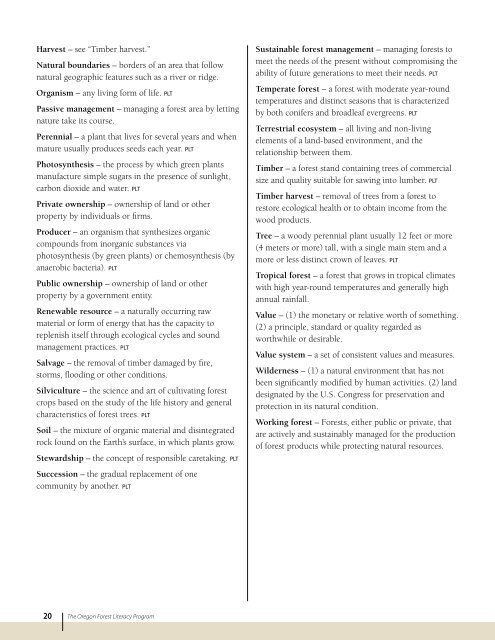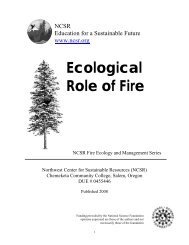Oregon Forest Literacy Program (PDF) - Learn Forests
Oregon Forest Literacy Program (PDF) - Learn Forests
Oregon Forest Literacy Program (PDF) - Learn Forests
You also want an ePaper? Increase the reach of your titles
YUMPU automatically turns print PDFs into web optimized ePapers that Google loves.
Harvest – see “Timber harvest.”<br />
Natural boundaries – borders of an area that follow<br />
natural geographic features such as a river or ridge.<br />
Organism – any living form of life. PLT<br />
Passive management – managing a forest area by letting<br />
nature take its course.<br />
Perennial – a plant that lives for several years and when<br />
mature usually produces seeds each year. PLT<br />
Photosynthesis – the process by which green plants<br />
manufacture simple sugars in the presence of sunlight,<br />
carbon dioxide and water. PLT<br />
Private ownership – ownership of land or other<br />
property by individuals or firms.<br />
Producer – an organism that synthesizes organic<br />
compounds from inorganic substances via<br />
photosynthesis (by green plants) or chemosynthesis (by<br />
anaerobic bacteria). PLT<br />
Public ownership – ownership of land or other<br />
property by a government entity.<br />
Renewable resource – a naturally occurring raw<br />
material or form of energy that has the capacity to<br />
replenish itself through ecological cycles and sound<br />
management practices. PLT<br />
Salvage – the removal of timber damaged by fire,<br />
storms, flooding or other conditions.<br />
Silviculture – the science and art of cultivating forest<br />
crops based on the study of the life history and general<br />
characteristics of forest trees. PLT<br />
Soil – the mixture of organic material and disintegrated<br />
rock found on the Earth’s surface, in which plants grow.<br />
Stewardship – the concept of responsible caretaking. PLT<br />
Succession – the gradual replacement of one<br />
community by another. PLT<br />
Sustainable forest management – managing forests to<br />
meet the needs of the present without compromising the<br />
ability of future generations to meet their needs. PLT<br />
Temperate forest – a forest with moderate year-round<br />
temperatures and distinct seasons that is characterized<br />
by both conifers and broadleaf evergreens. PLT<br />
Terrestrial ecosystem – all living and non-living<br />
elements of a land-based environment, and the<br />
relationship between them.<br />
Timber – a forest stand containing trees of commercial<br />
size and quality suitable for sawing into lumber. PLT<br />
Timber harvest – removal of trees from a forest to<br />
restore ecological health or to obtain income from the<br />
wood products.<br />
Tree – a woody perennial plant usually 12 feet or more<br />
(4 meters or more) tall, with a single main stem and a<br />
more or less distinct crown of leaves. PLT<br />
Tropical forest – a forest that grows in tropical climates<br />
with high year-round temperatures and generally high<br />
annual rainfall.<br />
Value – (1) the monetary or relative worth of something.<br />
(2) a principle, standard or quality regarded as<br />
worthwhile or desirable.<br />
Value system – a set of consistent values and measures.<br />
Wilderness – (1) a natural environment that has not<br />
been significantly modified by human activities. (2) land<br />
designated by the U.S. Congress for preservation and<br />
protection in its natural condition.<br />
Working forest – <strong>Forest</strong>s, either public or private, that<br />
are actively and sustainably managed for the production<br />
of forest products while protecting natural resources.<br />
20 The <strong>Oregon</strong> <strong>Forest</strong> <strong>Literacy</strong> <strong>Program</strong>



